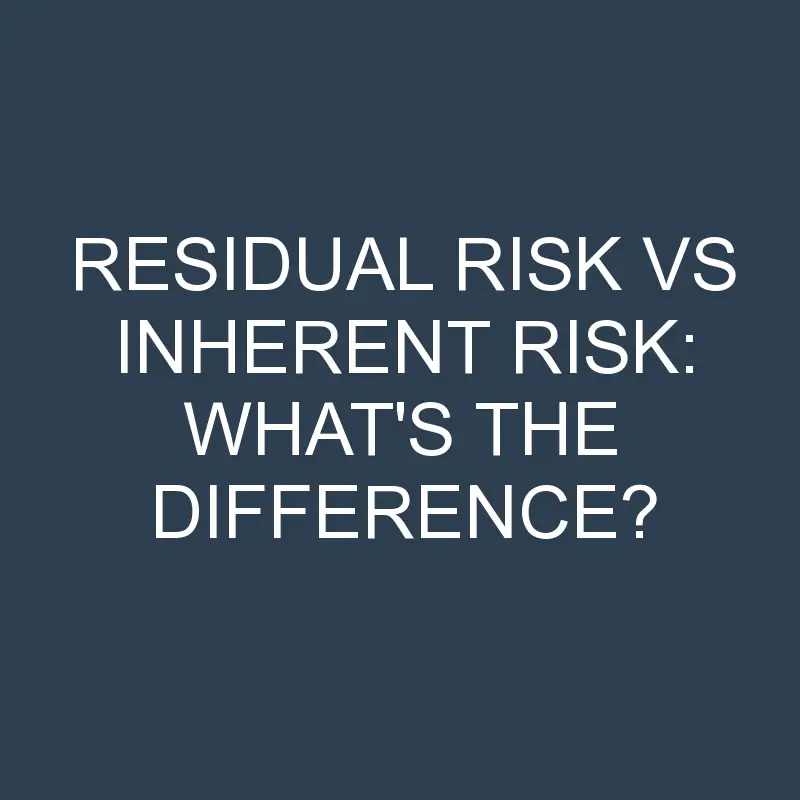Post Contents
Residual Risk Vs Inherent Risk: What’s the Difference?
In the business world, “risk” is a word that gets thrown around a lot. But what exactly is risk? And what are the different types of risk that businesses face? This article will explore the concept of risk and explain the difference between residual risk and inherent risk.
What is the residual risk?
Residual risk is the risk that remains after you have taken steps to mitigate inherent risk. In other words, it’s the risk that’s left over after you’ve done everything you can to reduce the risks inherent in a situation.
There are two types of residual risk: acceptable and unacceptable. Acceptable residual risk is the risk you’ve decided you can live with – it’s not ideal, but it’s something you’re willing to tolerate. Unacceptable residual risk is the risk that’s simply too high for you to tolerate.
The key to managing residual risk is to understand what risks are inherent in a situation and then take steps to mitigate them as much as possible. By doing this, you can minimize the amount of residual risk you’re exposed to and make sure that what risks remain are ones you’re comfortable with.
What is an inherent risk?
Inherent risk is the risk of loss that is inherent in any given situation. It is the risk that can not be avoided or mitigated. Inherent risk is often contrasted with residual risk, which is the risk that remains after all possible mitigation measures have been taken.
How do you manage residual risk?
There are a number of ways to manage residual risk. The most important thing is to identify what residual risks exist in your business and then put processes and controls in place to mitigate those risks. Here are some tips:
– Conduct a risk assessment: This will help you identify what residual risks exist in your business.
– Put controls and processes in place: Once you know what the risks are, you can put controls and processes in place to mitigate them. This might include things like insurance, safety procedures, or quality control measures.
– Monitor and review: It’s important to monitor and review your residual risk management plan on a regular basis to make sure it is effective.
How do you manage inherent risk?
There are a number of ways to manage inherent risk. One way is to simply avoid activities that pose a high inherent risk. Another way is to put controls in place that mitigate or eliminate the risks. For example, if you’re running a business, you might put in place financial controls to prevent fraud and embezzlement. Or, if you’re concerned about safety risks, you might put in place safety protocols to reduce the chances of accidents occurring.
In general, the best way to manage inherent risk is to be aware of it and take steps to mitigate it. By being proactive and putting controls in place, you can effectively reduce the inherent risk in any activity.
What’s the best way to reduce risk?
There are two ways to reduce risk: by reducing the inherent risk or by reducing the residual risk. Inherent risk is the amount of risk that is present in a situation without any mitigating factors. Residual risk is the amount of risk that remains after all possible mitigating factors have been taken into account.
So, what’s the best way to reduce risk? It depends on the situation. If you’re faced with a high inherent risk, then your best bet is to focus on reducing that risk. However, if you’re already facing a low inherent risk, then you may want to focus on reducing the residual risk instead.
Ultimately, the best way to reduce risk is to tailor your approach to the specific situation at hand. By taking into account both the inherent and residual risks, you can develop a plan that will minimize the overall amount of risk present.
Conclusion
In conclusion, it is important to understand the difference between residual risk and inherent risk. Residual risk is the amount of risk that remains after controls have been put in place, while inherent risk is the amount of risk that exists before any controls are put in place. By understanding the difference between these two types of risk, you can more effectively manage both and ensure that your business is as safe and successful as possible.
